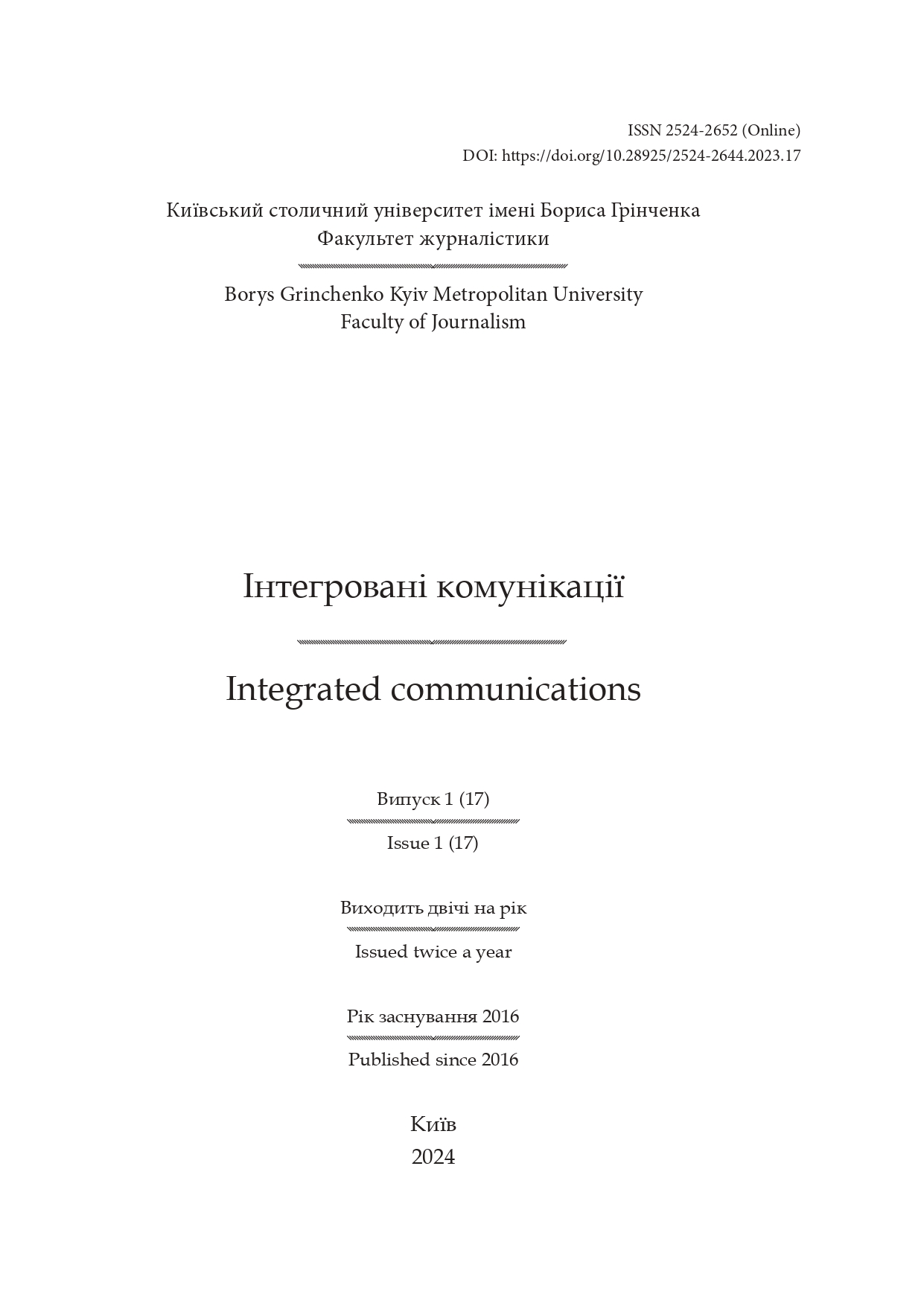MEDIA PRACTICE OF USING ARTIFICIAL INTELLIGENCE TECHNOLOGIES IN UKRAINE
Abstract
The article identifies and analyses the main cases and trends in using artificial intelligence technologies in domestic media activity. The article’s relevance lies in the need to study the peculiarities of using artificial intelligence in the media. It is because the active involvement of artificial intelligence in the field of journalism presents specialists with a number of new challenges and issues related to the quality, reliability, ethics and social responsibility of journalistic materials, as well as the role, status, rights and obligations of journalists and media audience. Artificial intelligence can create content that is difficult to distinguish from human content, leading to manipulation, deception, plagiarism, copyright infringement, etc.
A set of scientific research methods is used to achieve the goal: descriptive, systematization, comparative, analysis, synthesis, and generalization. The development vectors of projects with the involvement of artificial intelligence from the Associated Press – the first information agency that began to combine journalistic work with smart technologies were analyzed. The peculiarities of implementing artificial intelligence functionality in the media sphere are also investigated. Thus, the first examples of the use of content generated by artificial intelligence by well-known domestic information projects -«Bigus Info» and «Slidstvo Info» were highlighted; cases of the use of artificial intelligence in the publication «Texty.org» and the deep analytics blog «DeepStateUA» were considered. The article also attempts to investigate the transformative impact of artificial intelligence on the domestic media sphere. The research can be useful for a wide range of interested persons, in particular media practitioners, as well as teachers and students of higher education institutions and scientists. The article will contribute to increasing the number of scientific studies on the outlined topic and make it possible to extrapolate theoretical positions into the practical plane.
Downloads
References
Baranov, O. (2023). Vyznachennia terminu «shtuchnyi intelekt» [Defined by the term “piece intelligence”]. Informatsiia i pravo [Information and law]. Vol. 1(44). Pp. 32–49. Avaible at: https://ippi.org.ua/sites/default/files/5_28.pdf (accessed 15.02.2024).
V Ukraini stvoreno bazu pomichnykiv mistsevykh deputativ [A database of local deputies has been created in Ukraine]. Avaible at: https://nashigroshi.org/2017/09/21/v-ukrajini-stvoreno-bazu-pomichnykiv-mistsevyh-deputativ/ (accessed 23.02.2024) .
Harna khata [A beautiful house]. Bihus.Info. Avaible at: https://bihus.info/projects/garnakhata (accessed 23.02.2024).
Deza viiny [War disinformation]. Texty.org.u Avaible at: https://topic-radar.texty.org.ua/#/?from=2022-12- 19&to=2023-06-25 (accessed 22.01.2024).
Deklaratsii [Declarations]. Bihus.Info. Avaible at: https://bihus.info/projects/deklaraci (accessed 22.01.2024).
Kantseliarska sotnia [Office hundred]. DOCUCLAB. Avaible at: https://docuclub.docudays.ua/movies/item/kancelyarska-sotnya (accessed 25.02.2024).
Kontseptsiia rozvytku shtuchnoho intelektu v Ukraini: Rozporiadzhennia Kabinetu ministriv Ukrainy vid 02.12.2020 No1556-r [The concept of artificial intelligence development in Ukraine: Decree of the Cabinet of Ministers of Ukraine dated 02.12.2020 #1556]. Avaible at: https://zakon.rada.gov.ua/laws/show/1556-2020-%D1%80#Text (accessed 14.03.2024).
Lavryshyn, Y. (2023) Mapa, do yakoi «nemaie pytan». Yak pratsiuie proiekt DeepState [A map to which «there are no questions». How the DeepState project works]. MediaSapience. Avaible at: https://ms.detector.media/it-kompanii/post/32559/2023-07-31-mapa-do-yakoi-nemaie-pytan-yak-pratsyuie-proiekt-deepstate (accessed 12.03.2024).
Nanovska, V. (2023). Yak media pratsiuvaty z Bing AI? Zapytannia ta pidkazky dlia chat-bota [How does media work with Bing AI? Questions and tips for the chatbot]. Mediameiker. Avaible at: https://mediamaker.me/yak-media-praczyuvaty-z-bing-ai-zapytannya-ta-pidkazky-dlya-chat-bota-1706 (accessed 12.03.2024).
Oliinyk, T. Yak redaktsii u vsomu sviti vprovadzhuiut ShI- doslidzhennia [How newsrooms around the world are implementing AI research]. Avaible at: https://tokar.ua/read/92848/yak-redaktsii-u-vsomu-sviti-vprovadzhuiut-shi-doslidzhennia (accessed 19.03.2024)
Posipaky [Minions]. Bihus.Info. Avaible at: https://bihus.info/projects/posipaki (accessed 15.03.2024)
Posipaky-2 [Minions-2]. Miniminiony. Bihus.Info. Avaible at: https://bihus.info/projects/posipaki/ (accessed 15.03.2024)
Rekomendatsii Komisii z zhurnalistskoi etyky shchodo vykorystannia shtuchnoho intelektu dlia stvorennia zhurnalistskykh materialiv. Komisiia z zhurnalistskoi etyky (2023) [Recommendations of the Commission on Journalistic Ethics regarding the use of artificial intelligence for the creation of journalistic materials. Commission on journalistic ethics]. Avaible at: https://cje.org.ua/statements/rekomendatsii-komisii-z-zhurnalistskoi-etyky-shchodo-vykorystannia-shtuchnoho-intelektu-dlia-stvorennia-zhurnalistskykh-materialiv (accessed 15.03.2024)
Stratehiia rozvytku shtuchnoho intelektu v Ukraini: monohrafiia [Strategy for the development of artificial intelligence in Ukraine: monograph] / za zah. red. A. I. Shevchenka. Kyiv. 2023. Avaible at: https://jai.in.ua/archive/2023/ai_mono.pdf (accessed 10.03.2024).
Trapeznikova, D. (2023). Chitko hovoryt i vvichlyvo posmikhaietsia. Yakby ukrainski media buly liudmy: ShI zmalovuie 8 personazhiv [Speaks clearly and smiles politely. If Ukrainian media were people: AI portrays 8 characters]. Mediameiker. Avaible at: https://mediamaker.me/yakby-ukrayinski-media-buly-lyudmy-shi-uyavlyaye-8- vydan-1712 (accessed 11.03.2024).
Aftermath VR: Euromaidan. Mystetskyi Arsenal [Art arsenal]. Avaible at: https://artarsenal.in.ua/vystavky/ekspozycia/aftermath-vr-euromaidan/ (accesed 20.02.2024).
Associate Press. The Future of Augmented Journalism: A guide for newsrooms in the age of smart machines 2017. 26 р. Avaible at: https://broadcastnewsabrahamsen.files.wordpress.com/2017/09/ap_insights_t-he_future_of_augmented_journalism.pdf (accessed 20.02.2024).
DeepStateMap. DeepStateUA. Avaible at: https://deepstatemap.live/#6/47.324/35.991 (accessed 20.03.2024).
Griselda. Avaible at: https://www.griselda.com.ua/ (accessed 14.03.2024).
Guzman, A. (2018). What is Human-Machine Communication, Anyway? New York, Peter Lang Publishing. Pp. 1–28. Avaible at: https://www.researchgate.net/publication/327043706_What_is_Human-Machine_Communication_Anyway (accessed 15.02.2024).
Lewis, S. et. al. (2019). Artificial Intelligence and Journalism. Journalism & Mass communication Quarterly. September. Pp. 673–695. Avaible at: https://journals.sagepub.com/doi/epub/10.1177/1077699019859901 (accessed 15.02.2024).
Lewis, S. Usher, N. (2013). Open source and journalism: toward new frameworks for imagining news innovation. Media, Culture & Society. Vol. 35. July. Pp. 602– 619. Avaible at: https://journals.sagepub.com/doi/epub/10.1177/0163443713485494 (accessed 15.02.2024).
Lewis, S., Guzman, A., Schmidt, T. (2019). Automation, Journalism, and Human-Machine Communication: Rethinking Roles and Relationships of Humans and Machines in News. Digital Journalism. Vol. 7. Pp. 409– 427. Avaible at: https://www.tandfonline.com/doi/full/10.1080/21670811.2019.1577147 (accessed 15.02.2024).
Russel, S, Norvig, P. (2022). Artificial Intelligence: A Modern Approach. 4th US ed. 1292 p. Avaible at: https://aima.cs.berkeley.edu/ (accessed 18.02.2024).
Shyam, S. (2008). The MAIN Model: A Heuristic Approach to Understanding Technology Effects on Credibility. Cambridge, MA: The MIT Press. Pp. 73–100. Avaible at: https://www.issuelab.org/resources/875/875.pdf (accessed 18.02.2024).
SPEKA.media. Avaible at: https://speka.media/dossier/latest/all (accessed 20.03.2024).
Tejedor, S. & Vila, P. (2021). Exo Journalism: A Conceptual Approach to a Hybrid Formula between Journalism and Artificial Intelligence. Pp. 830–840. Avaible at: https://www.mdpi.com/2673-5172/2/4/48 (accessed 18.02.2024).
The 2023 Global Outsourcing 100. IAOP. Avaible at: https://www.iaop.org/Content/19/165/5657 (accessed 15.02.2024).
Wang, P. (2008). What Do You Mean by «AI». Proceedings of the 2008 conference on Artificial General Intelligence 2008: Proceedings of the First AGI Conference. June. Pp. 362–373. Avaible at: https://www.researchgate.net/publication/262357941_What_Do_You_ Mean_ by_AI (accessed 18.02.2024).




